Basic China Pieces Illustrated Guide
How to Identify What You Have
The world of china dinnerware is vast and varied. There are thousands of manufacturers, hundreds of thousands of patterns, and many pieces to each pattern. To acquire a comprehensive knowledge of the industry requires a lifetime of study. However, there are some china basics that are easy to learn and remember, but are still unknown to many people who could benefit from the information. Learning some common china terms can improve your ability to buy, sell or enjoy china dinnerware.
There is much uncertainty with regard to the names of different china pieces. Since there are no official guidelines, confusion is the inevitable result. What some call a salad plate is referred to by others as a side plate, a creamer is also known as a milk jug etc. It is also difficult to determine proper nomenclature when there are different sizes involved. For example, if a 7 ½ inch plate is a salad plate, is a 8 ½ inch plate a luncheon plate or is it still called a salad plate? Is a two-handled cup part of a cream soup set or soup cup? This dilemma affects many who attempt to purchase china and would like to know exactly what they should be looking for.
An attempt to name and explain every piece ever made is beyond the scope of this guide. Instead, let us focus on some of the more common pieces available. There is no right or wrong when it comes to piece names, but by using the more common term, you will increase the likeliness of getting the information you are looking for.
China Pieces
The standard unit of china pieces which are sold together is the Five Piece Place setting, which usually consists of the following pieces: Dinner Plate, Salad Plate, Bread & Butter Plate, Cup and Saucer.
| Dinner Plate | Ø One of the main pieces of a china set, part of the standard five piece place setting.
Ø Flat, usually round, ranges from 9 3/4” to 11” in diameter |
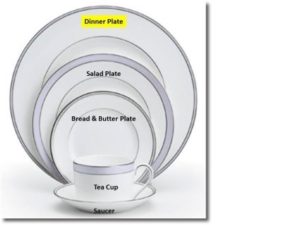 |
| Salad Plate (aka side plate) | Ø Part of the standard five piece place setting, the salad plate is flat, usually round and ranges from 7″ to 9″.
Ø Typically used for salad, appetizers and desserts. |
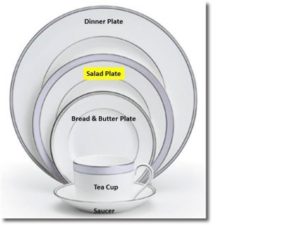 |
| Bread & Butter Plate (aka dessert plate, cake plate) | Ø Round plate is flat, usually ranging from 5″ to 7″ in diameter.
Ø Part of the standard five piece place setting. |
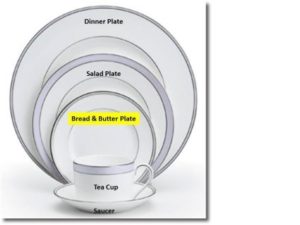 |
| Tea Cup (aka coffee cup) | Ø Comes in many different styles and shapes (Leigh, Peony, Footed, Flat etc.) ranges from 2” to 2 3/4” in height | 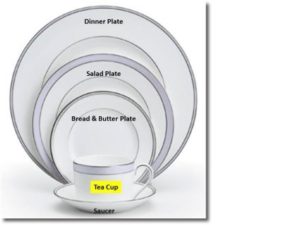 |
| Saucer | Ø Flat, round, with indentation for the cup | 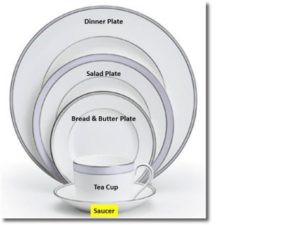 |
There additional pieces, while usually not part of the place setting, are often part of the formal table.
| Cereal Bowl | Ø The bowl in between the fruit dessert bowl and the soup bowl, usually ranging from 6″ – 7″.
Ø Comes rimmed or coupe (no rim), used to serve cereal or oatmeal at mealtime. |
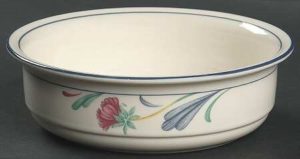 |
| Charger (often confused with the dinner or chop (12” serving) plates) | Ø Flat, usually round, ranges from 11” to 12” in diameter
|
 |
| Cream Soup & Saucer (aka soup cup) | Ø Similar to the bouillon cup and saucer, just bigger.
Ø Features a short and wide cup with two handles with an indented saucer underneath. Ø Used for soups or warm broths. |
 |
| Demitasse Cup & Saucer (aka after dinner, chocolate) | Ø Much smaller than regular tea cups, usually used for liquids drunk in moderation such as espresso, Turkish coffee or liqueurs.
Ø Come footed or flat, saucer usually indented |
 |
| Fruit/Dessert Bowl | Ø Comes rimmed or coupe (no rim), ranges from 4” to 5 3/4” | 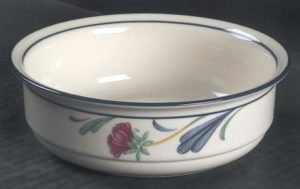 |
| Luncheon Plate (often confused with the dinner or salad plates) | Ø Flat, usually round, ranges from 9” to 9 3/4” in diameter |  |
| Mug | Ø Tall handled cup used usually for coffee or juices, often with accented designs.
Ø Without a saucer. Ø Flat or footed, occasionally differs slightly in design from the rest of the pattern. |
 |
| Soup Bowl | Ø Comes rimmed or coupe (no rim), ranges from 7 1/4” to 9”
Ø A round, open dish with a bowl deep enough to contain soup. Ø Can have a rip that extends outward (rimmed) or can be rimless (coupe). |
|
Serving pieces also come in a wide range of piece types, sizes and shapes. The following are some of the most common pieces:
| Bouillon Cup and Saucer | Ø Similar to a cream soup and saucer set, only smaller.
Ø Features a cup with two handles. Ø Not common to many dinner patterns, especially newer ones. |
 |
| Bud Vase | Ø Very small vase for holding flowers, usually not more than three stems. |  |
| Butter Pat | Ø Small, round saucer-like china piece, used to serve individual pieces of butter. |  |
| Chop Plate | Ø A round plate, 12″ to 13″ in diameter, usually used as a serving plate. Similar to a charger. |  |
| Coffee Pot with Lid | Ø Tall and thin |  |
| Covered Vegetable Bowl | Ø Round or oval, double handled, often confused with soup tureen, which is much bigger | 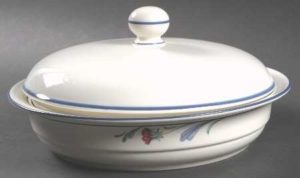 |
| Creamer (aka milk jug) | Ø Small jug with spout used for serving cream to go along with hot beverages.
Ø Handle, with spout for pouring, many different sizes, often even for the same pattern Ø Comes in many shapes. |
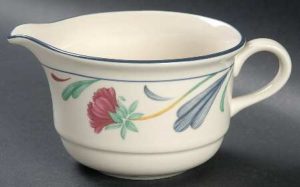 |
| Dessert Plate | Ø An addition to the five piece place setting, it usually ranges from 7″ to 8″ in diameter.
Ø Sometimes interchangeable with the accent plate and the cream soup saucer (although the latter usually features an indentation for the cup). |
|
| Gravy Boat & Underplate (platter) | Ø Underplate comes separate or attached.
Ø Usually with handle, occasionally with double spout. |
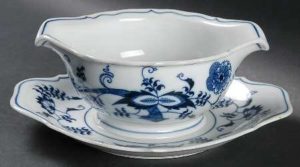 |
| Oval Serving Platter (aka meat platter) | Ø Comes in many different sizes, starting from 10 all the way to 19” in length, occasionally even bigger (length is the determining factor, not width).
Ø When referring to platters, actual size is important. “Big” or “small” mean different things to different people. Ø Use the actual length to clarify what you are referring to. |
|
| Oval Vegetable Bowl (aka salad bowl, serving bowl, open vegetable bowl) | Ø Rimmed and coup (no rim), used for salads, pasta etc., ranges from 9” to 10 ¾” | 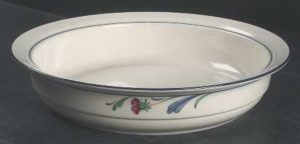 |
| Round Vegetable Bowl (aka salad bowl, serving bowl) | Ø Rimmed and coup (no rim), used for salads, pasta etc., ranges from 8” to 10 ¾” | 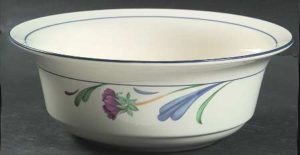 |
| Sugar Bowl | Ø Small dish used for serving sugar, usually comes with a cover.
Ø Almost always with handles. Ø Can be in many shapes including leigh, peony, Queen Anne etc. |
 |
| Tea Pot with Lid | Ø Short and stout | 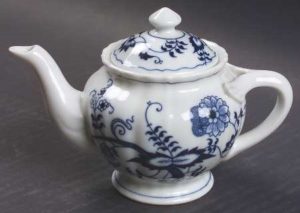 |
| Tureen or Soup Tureen | Ø Large round bowl with lid
Ø Usually footed, occasionally with underplate or nook for ladle |
 |



